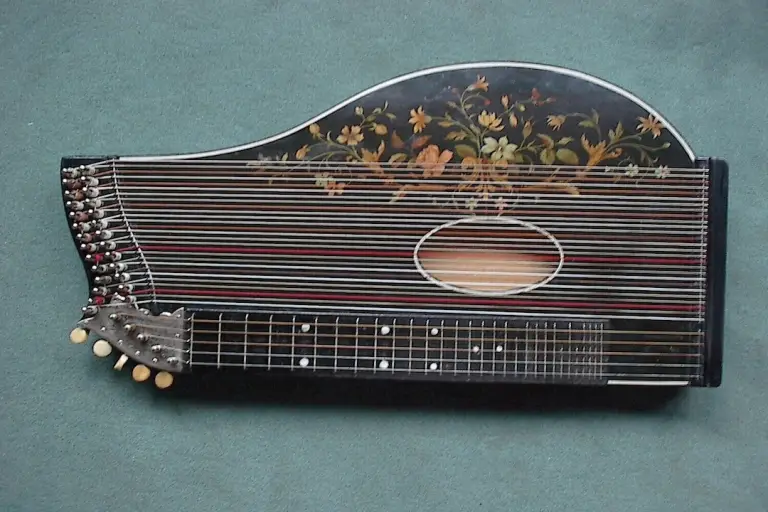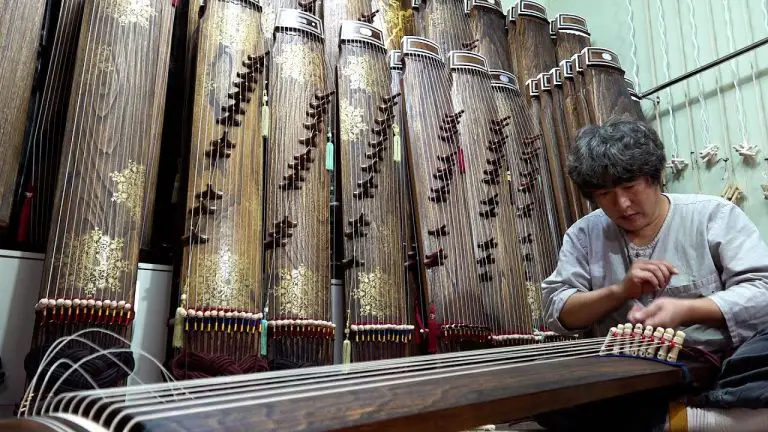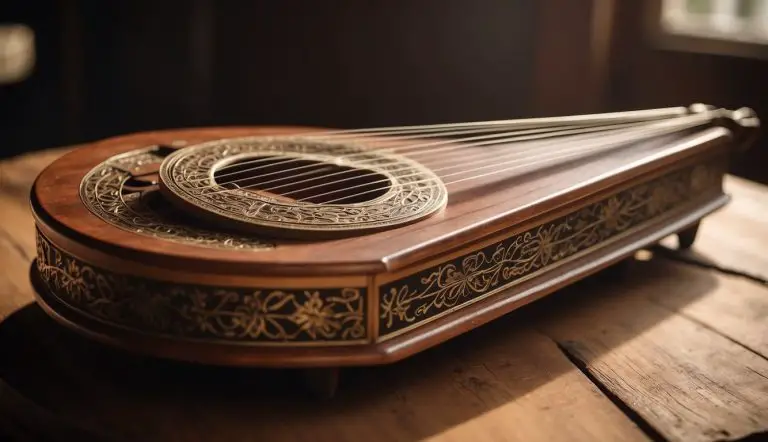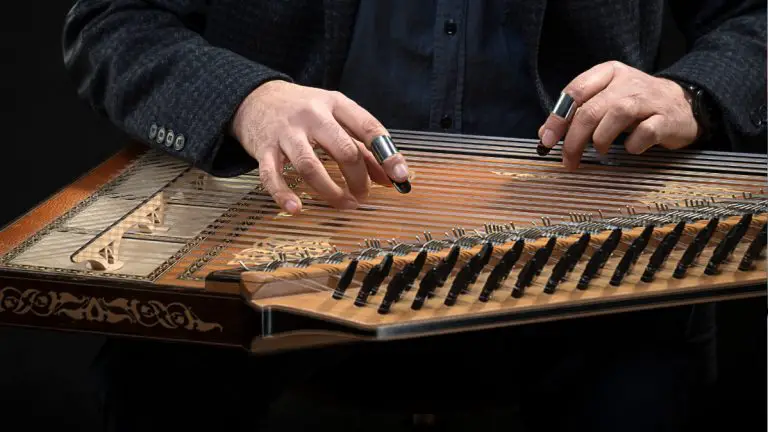Who Are Some Famous Zither Instrument Players? Let’s Find Out!
Folkstrings.com is reader-supported. When you buy through links on our site, we may earn a small commission.
The zither is a musical instrument that has enchanted audiences with its melodious strings and unique sound for centuries.
Among its illustrious players are people who have elevated the zither’s status from a traditional instrument to one that resonates on international concert stages.
These musicians have showcased the instrument’s versatility across different musical genres, from classical arrangements to contemporary compositions.
Despite the variety of zithers, such as the Chinese guqin, the Austrian Alpine zither, and the American autoharp, all these instruments share the common feature of having strings stretched across a flat body.

Famous zither players are often the ambassadors of their instrument, both preserving traditional playing techniques and innovating new ways to communicate through their music.
The guqin, for example, has been played by virtuosos who are able to evoke the instrument’s historical significance while staying relevant in modern music scenes.
Similarly, the Alpine zither has seen maestros who have brought its charming sounds to wider audiences around the world.
These artists are not just performers but often educators and stewards of the zither’s rich heritage, connecting the past and present through their skill and passion for the instrument.
Key Points
- The zither has been popularized by renowned players who perform internationally.
- These artists innovate while preserving traditional zither playing styles.
- Zither musicians contribute to the cultural heritage and education of the instrument.
Table of Contents
History and Types of Zithers

The zither is a fascinating and diverse family of stringed instruments that has evolved over centuries. With various forms globally, they share the common trait of strings stretched across a resonating chamber or sound box.
Early Forms and Development
My exploration of the zither begins with its early forms, such as the simple musical bow and stick zither.
Dating back to ancient times, these instruments evolved into more complex types like the tube zither.
I learned that one particularly early form of the zither in Europe was known as the scheitholt, which is believed to have influenced other well-known instruments such as the clavichord, harpsichord and even the piano.
Looking at the Asian zithers, the guqin, also called the Chinese qin, stands out as one of the oldest.
This venerable instrument has seven metal strings and has been revered in Chinese culture for its purity of sound and connection to scholarly arts.
Similarly, the Japanese koto, a long zither with movable bridges, and the guzheng have their unique positions in the history of zithers.
The iconic Austrian zither, encompassing variations like the Salzburg zither and Mittenwald zither, has been a significant part of Alpine music tradition.
Its delicate strings and complex playing method have made it synonymous with the serene beauty of the region.
In the 19th century, Michael Praetorius gave one of the first comprehensive documentations of these instruments, which has been invaluable for our understanding of their development.
Types of Zithers
My fascination leads me towards the numerous types of zithers that have been developed around the world. They carry distinct sounds and cultural significance.
The concert zither and Alpine zither are varieties often associated with European music, characterized by their fingerboard amidst the unconstrained strings.
Here’s a brief categorization of the types I’ve found:
- Chord zither: Unlike the concert zither, these have no fingerboards and strings are plucked to produce full chords.
- Bar zither: Includes the modern autoharp, where bar presses dampen unwanted strings to form chords.
- Tube zither: Examples include the Malagasy valiha or the Filipino kubing.
- Board zither: Such as the Appalachian dulcimer and psaltery, these often have a flat wooden body.
- Resonated zither: The Chinese yangqin and Persian santur fall into this category, featuring a trapezoidal sound box.
A table summarizing some zithers and their characteristics:
| Type | Description | Notable Use |
|---|---|---|
| Concert zither | Fingerboard + open strings | European classical and folk |
| Alpine zither | Alpine regions, Austria/Germany | Alpine music |
| Chord zither | Multiple chords, no fingerboard | Folk music |
| Bar zither | Keyed mechanism for chords | Folk and educational |
| Tube zither | Hollow tube body | Traditional music in Madagascar, Southeast Asia |
| Board zither | Flat board body | Folk music worldwide |
| Resonated zither | Large resonating sound box | Classical music in Asia, Middle East |
Each type of zither offers a unique sound and playing technique, reflecting the cultural background from which it originated.
The Appalachian dulcimer and the autoharp are notable examples of zithers adapted for use in American folk music.
The qānūn, with its visible similarities to the western salzburg zither but played in a distinctly Middle Eastern style, showcases the adaptability of this instrument’s design.
Famous Zither Players and Their Contributions

I’m excited to share with you some of the most renowned zither players, makers, and ensembles. Each has significantly shaped the zither landscape through their mastery, innovation, and collective performances.
Zither Virtuosos
In the realm of zither virtuosos, several names have left an indelible mark on the art of zither playing.
Franz Waldecker was an influential figure, not only as a director who led zither clubs but also as a concert zither player who enriched the repertoire with his performances.
Zither virtuosity has also found a unique expression in Japan through the koto, a Japanese zither, played by expert musicians.
- Notable Zither Players:
- Franz Waldecker
- Japanese Koto Virtuosos
Zither Composers and Makers
Among zither composers and makers, Franz Schwarzer stands out as an esteemed zither maker whose contributions deeply impacted the zither community.
His finely crafted instruments played a crucial role in popularizing the zither in America.
Another notable figure is Alberta Krader, whose mastery in both playing and teaching the zither helped sustain and spread the traditional music associated with this stringed instrument.
- Prominent Zither Figures:
- Makers: Franz Schwarzer
- Players & Educators: Alberta Krader
Prominent Zither Ensembles
Speaking of ensembles, the Los Angeles Zither Ensemble has been a beacon for zither music lovers.
It showcases the versatility and collaborative spirit within the zither community.
In addition, zither clubs, such as those in Philadelphia, have played a pivotal role in nurturing talents and keeping the tradition of zither music alive.
These groups often feature the concert zither, a type of zither that has its own dedicated following and specialized repertoire.
- Influential Zither Groups:
- Los Angeles Zither Ensemble
- Philadelphia Zither Clubs
Playing the Zither: Techniques and Styles
When I approach the zither, I’m engaging with a versatile instrument that encompasses various regional types, from the European zither with a fingerboard to the stringed elegance of the Japanese koto.
Mastering the zither requires understanding both the basic and advanced playing techniques, with each style reflecting the uniqueness of this instrument.
Basic Playing Techniques
The foundation of playing any zither lies in the delicate balance between the left and right hand functions.
With my left hand, I typically press down on the strings against the fingerboard (if one is present, as in a European zither) to alter pitch, while my right hand may pluck the strings directly with the fingertips or use a plectrum for a sharper attack.
On the zither without a fingerboard, such as a dulcimer or Chinese guzheng, my left hand must expertly control the pressure and position on the strings to create the correct pitch and tonal expression.
- Right Hand:
- Plucking: I use my fingers or plectrum to elicit sound.
- Strumming: Occasionally, I may strum across melody strings for a fuller sound.
- Left Hand:
- Finger Placement: Precision and accuracy are key for pitch control.
- Pressure: Varying pressure can produce subtle changes in tone.
String groupings are another aspect that I pay attention to, categorizing strings into accompaniment and melody types.
The accompaniment strings may be played in a rhythmic fashion, often reflecting a harmonic backdrop, while the melody strings carry the tune I wish to convey.
Advanced Performance Techniques
As my play progresses, I explore more advanced techniques that add emotional depth and complexity to my performance.
I may incorporate vibrato with my left hand to add richness to the sustained notes. I also dare to perform rapid arpeggios and intricate fingerings that showcase my proficiency and the agility of the zither.
- Vibrato: I create this effect by rocking my finger on a string after plucking it, much like a violinist might.
- Fingerings: Whether it’s a complex sequence of notes or a technique unique to the instrument like the fan-shaped strumming on the guzheng, these advanced finger movements require practice.
Playing solo on the zither is a true test of my skills, as it demands comprehensive control over all these techniques to reflect the full range of sound that the zither’s soundboard can produce. I can also use the instrument to accompany others, bringing out the harmonious and supportive role of the zither in ensemble pieces. Throughout my explorations, the zither reveals its capacity to both lead with striking melodies and provide a rich tapestry of accompaniment.
Learning the Zither

When I embarked on the journey to learn the zither, it became clear to me that immersing myself in its music and joining a community were essential steps for enhancing my skills and appreciation for this instrument.
Zither Music and Repertoire
In my experience, starting with the European zither repertoire was the best way to understand the instrument’s capabilities.
European zithers typically consist of melody strings stretched over a fingerboard and a larger number of accompaniment strings, all offering a rich array of sounds.
With my zither laid out before me, I practiced plucking the strings adjacent to the fingerboard to produce clear melodies, while the rest provided the harmonic and rhythmic foundation.
As I progressed, I explored various categories of music, diving into folk tunes from Central Europe, where the zither has a storied history, and mastering pieces by influential composers like Franz Waldecker, known for advancing the art of zither playing.
Joining Zither Clubs and Communities
Connecting with zither clubs played a pivotal role in my development as a zither player.
I found that zither clubs are pockets of culture where I could share and learn new techniques, get feedback, and form lasting friendships. Here’s how I dove into the zither community:
- Find a Local Club: I located a nearby zither club for regular meet-ups and practice sessions.
- Online Forums: Participation in online communities helped me when physical meetings weren’t possible.
- Events and Performances: By attending concerts and events, I observed and learned from accomplished zither players.
Through these experiences, I not only improved my technique but also gained insight into the cultural significance of the instrument. Engaging with the zither community brought me closer to the soul of the music, and instilled a sense of shared tradition that made every chord and melody even more meaningful.
Cultural Significance of the Zither
In my exploration of the zither, a stringed instrument with historical roots, I’ve been captivated by its significance across various cultures. The zither belongs to a category of instruments characterized by a flat soundbox with multiple strings stretched across it.
For example, the guzheng, a Chinese zither, is embedded deeply in traditional music. Its music often reflects Chinese values and philosophies and is considered an integral part of cultural heritage.
Similarly, the Japanese koto, a type of zither, carries a significant cultural weight, often being central to Japanese classical music and storytelling.
The Austrian zither, though less globally known, is no less important. It carries a charm that fuses folk with classical technique, offering a unique sonic experience deeply tied to the Alpine regions’ cultural identity.
Throughout history, these instruments have been the heart of storytelling, ritual, and education. They mirror the societal values of their respective cultures and continue to influence modern performances. Below is a breakdown of the primary zithers and their cultural significance:
- Guzheng: Pivotal in Chinese music, representing tradition.
- Japanese Koto: Central to Japanese music, often used in collaboration with poetry.
- Austrian Zither: Reflective of Alpine folklore, a bridge between folk traditions and classical motifs.
Through these zithers, I’ve learned that music exceeds mere entertainment; it’s a cultural dialogue between the past and present. Each string resonates with tales of time and tradition, offering a thread that connects us to the rich tapestry of human expression.
Frequently Asked Questions
In this section, I’ll address some common curiosities about zither musicians and the instrument itself.
We’ll get to know some of the notable players, historical figures, and specific details about the zither that enthusiasts often inquire about.
Which contemporary musicians are renowned for playing the zither?
Contemporary zither enthusiasts admire musicians like Andreas Vollenweider, who is known for his eclectic and innovative approach to playing the electric zither.
His work has garnered a global audience, blending traditional techniques with modern sounds.
Can you name some notable women in the zither music scene?
Merten’s Molly, Mia Theodoratus, and Cornelia Mayer are a few of the remarkable women who have made their mark in the zither world.
They have each contributed to the appreciation and evolution of this traditional instrument in their unique ways.
Who is a historically significant figure known for playing the zither?
One historically significant zither player is Johann Petzmayer, a master of the Viennese zither in the 19th century, often credited with popularizing the instrument in the Western world through his virtuosic performances.
What style of zither was used by the legendary musician Anton Karas?
Anton Karas famously played the concert zither.
He brought it to international fame with his soundtrack for the film “The Third Man,” which showcased the instrument’s potential for both melody and accompaniment.
Could you describe the appearance of a traditional zither instrument?
A traditional zither typically has a long, flat body made of wood with strings running across its length. It combines elements of both string and percussion instruments with a series of melody strings on one side and accompaniment chords on the other.
What are the typical measurements of a concert zither?
The concert zither usually measures about 50 to 60 cm in length. It also has a width of approximately 30 to 40 cm. Its size allows for a range of tones, enabling musicians to perform complex and nuanced pieces.
Author Profile
-
Daniel Johnstone is an English writer with a love for stringed instruments from around the world.
He shares his love for these instruments through his writing for folkstrings.com, a website dedicated to all things related to folk string music.
Daniel's passion for music started at a young age, and he has since become an accomplished musician, playing guitar, cavaco, and recently, the harp.
His dedication to learning and sharing his knowledge of stringed instruments is evident in his insightful and engaging blog posts. Whether you're a seasoned musician or a beginner, Daniel's writing is sure to inspire and entertain you.
When he's not playing music or writing, you can find Daniel exploring new instruments and seeking out new sounds to share with his readers.
Latest entries
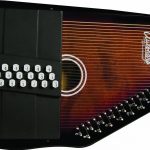 AutoharpApril 4, 2024What Is the Autoharp Made Of: Exploring Its Materials and Craftsmanship
AutoharpApril 4, 2024What Is the Autoharp Made Of: Exploring Its Materials and Craftsmanship AutoharpApril 4, 2024Is Autoharp Easy to Play? Unveiling the Truth for Beginners
AutoharpApril 4, 2024Is Autoharp Easy to Play? Unveiling the Truth for Beginners AutoharpApril 4, 2024What Is an Autoharp Worth? Your Guide to Pricing and Value
AutoharpApril 4, 2024What Is an Autoharp Worth? Your Guide to Pricing and Value AutoharpApril 4, 2024Are Autoharp and Zither the Same Thing? Unraveling String Instrument Myths
AutoharpApril 4, 2024Are Autoharp and Zither the Same Thing? Unraveling String Instrument Myths
Affiliates:
This post may contain affiliate links that at no additional cost to you, the site may earn a small commission. We only recommend products we would use ourselves and all opinions expressed on this site are our own.
Accuracy Advice:
While we strive to provide up-to-date and accurate information, the content in this article may not reflect the most current research or medical guidelines. We encourage readers to do further research and consult with professionals for more personalized advice.
Our Recommendations:
The products and services mentioned in any of our articles are recommended based on our independent research and personal experience. We are not sponsored by any company. We aim to suggest products and services we believe are of high quality and could be beneficial to our readers.


